

The Ghan –
A Journey Through My Eyes
What makes the journey from Darwin to Adelaide, one of the great continental traverses?
The from Darwin to Adelaide is truly one of the world’s greatest continental traverses. It showcases the stunning landscapes and the unique features of the Australian outback. From the rugged coastlines and tropical forests of the Top End, through the arid deserts and ancient mountain ranges of the Red Centre, the journey offers a glimpse into the heart of the Australian continent and the rich cultural history of the indigenous peoples who have lived here for thousands of years.
It is a journey that I first covered in the early 1980’s and subsequently on many occasions with the Michigan Team in the World Solar Car Challenge, a team that I have shared some of the great crossings of the USA, the old Route 66, from south to north, Dallas to Winnipeg (and on to Calgary), and from Omaha to Bend (Oregon). Each is unique, but none compare with the Australian
This art project brings my impressions from these trips, to share with you, what makes it special to me. To share the stunning landscape, to get a feel for the toughness of the early pioneers, to get a feel for the sense of journey and what can be taken from it.



What makes The Ghan Trip Epic
The Ghan Railway trip from Darwin to Adelaide is an epic journey that offers an unparalleled opportunity to experience the vast and rugged beauty of Australia’s outback. Passengers experience the breathtaking views of the outback landscape, as well as the chance to learn more about the history and culture of the indigenous peoples who have lived there for millennia and sample some of the region’s unique cuisine and experience the warmth and hospitality of the Australian people. There are several factors that make this trip truly epic.
- The stunning landscapes: The Ghan Railway trip takes you through some of the most spectacular and diverse landscapes in Australia, including the tropical Top End, the starkly beautiful Red Centre, and the rolling hills and vineyards of South Australia. Along the way, you’ll see towering mountains, deep gorges, vast deserts, and stunning rock formations.
- The sense of adventure: The Ghan Railway trip is a true adventure, as you travel through remote and wild landscapes that are inaccessible by any other means. The train crosses vast distances, passing through rugged terrain and stopping at small outback towns along the way. You’ll feel like a true explorer as you venture deep into the heart of Australia. The train makes a stop in Katherine, where passengers can take a scenic helicopter tour over the spectacular Nitmiluk Gorge. The train continues south, passing through the Red Centre of Australia, home to the iconic Uluru and Kata Tjuta. The train makes a stop at the historic town of Alice Springs which played a vital role in the early development of rail and telegraph communication in the region. Here passengers can take a guided tour of the town or take a scenic flight over the surrounding desert.
- The sense of history: The Ghan Railway has a rich and fascinating history that dates back to the early 20th century, when it was originally built to connect the north and south of the country. Today, the trip is a tribute to this pioneering spirit, as you follow in the footsteps of the early explorers and settlers who opened up this vast and challenging and.
- An onboard experience: The Ghan Railway trip offers a truly luxurious onboard experience, with comfortable cabins, delicious meals, and a range of activities and excursions to enjoy along the way. You’ll have plenty of opportunities to relax and unwind, as well as to meet other travellers and share your experiences of this epic journey.
Overall, the Ghan Railway trip from Darwin to Adelaide is a truly epic journey that combines stunning landscapes, a sense of adventure, a rich sense of history, and a luxurious onboard experience. It is a once-in-a-lifetime experience that will stay with you forever.

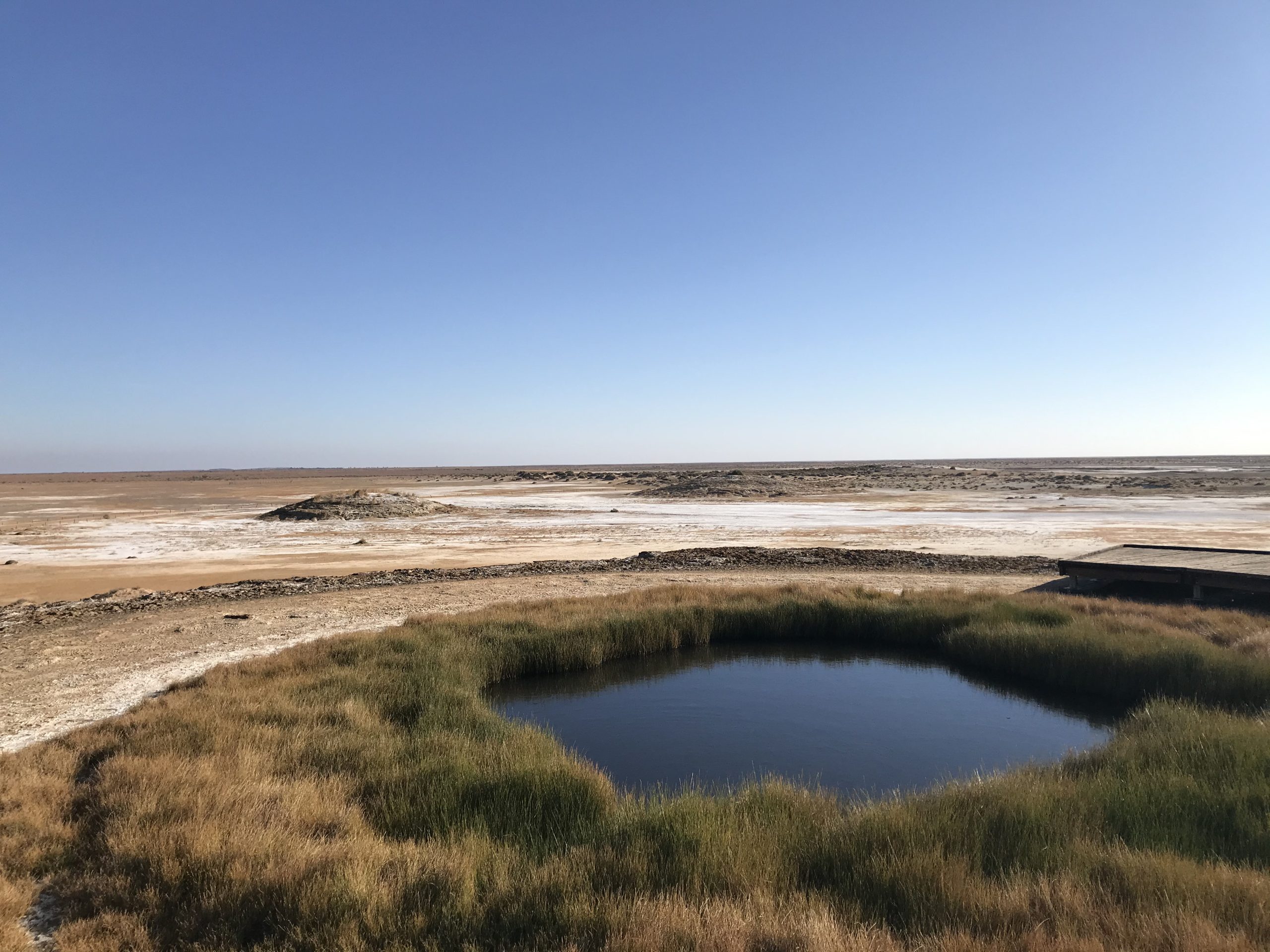
A Journey Through History
At its’ core, the Ghan Railway journey provides a unique perspective on the history, culture, and natural beauty of the Australian Outback. It is a tribute to the pioneering spirit and resilience of the Australian people, who have worked tirelessly to overcome the harsh and unforgiving terrain of the outback to forge a path of progress and development for the nation. From the earliest days of the indigenous trading routes that crisscrossed the landscape to the modern engineering marvels of the Ghan railway itself, the story of the Australian outback is one of resilience, perseverance, and innovation.
Ultimately, the story of the Ghan railway journey is a testament to the indomitable spirit of the Australian people, who have worked tirelessly to overcome the challenges of the outback to build a better future for themselves and their families. Whether you are a seasoned traveller or a first-time visitor to the region, the Ghan railway journey is a once-in-a-lifetime experience that is not to be missed.
The Indigenous Trading Route – The Mound Springs
The history of the Ghan Railway journey is closely tied to the indigenous trading routes that followed the mound springs of the Australian outback. The water resources that were essential to the steam locomotives that powered the first steam trains to Marree and beyond. It wasn’t really until the development of diesel locomotives that the rail could be extended to Darwin.
The ancient mound springs that provided a water to sustain indigenous communities also served to made Stuart’s expedition through the centre feasible, and eventually the development of the Inland telegraph.
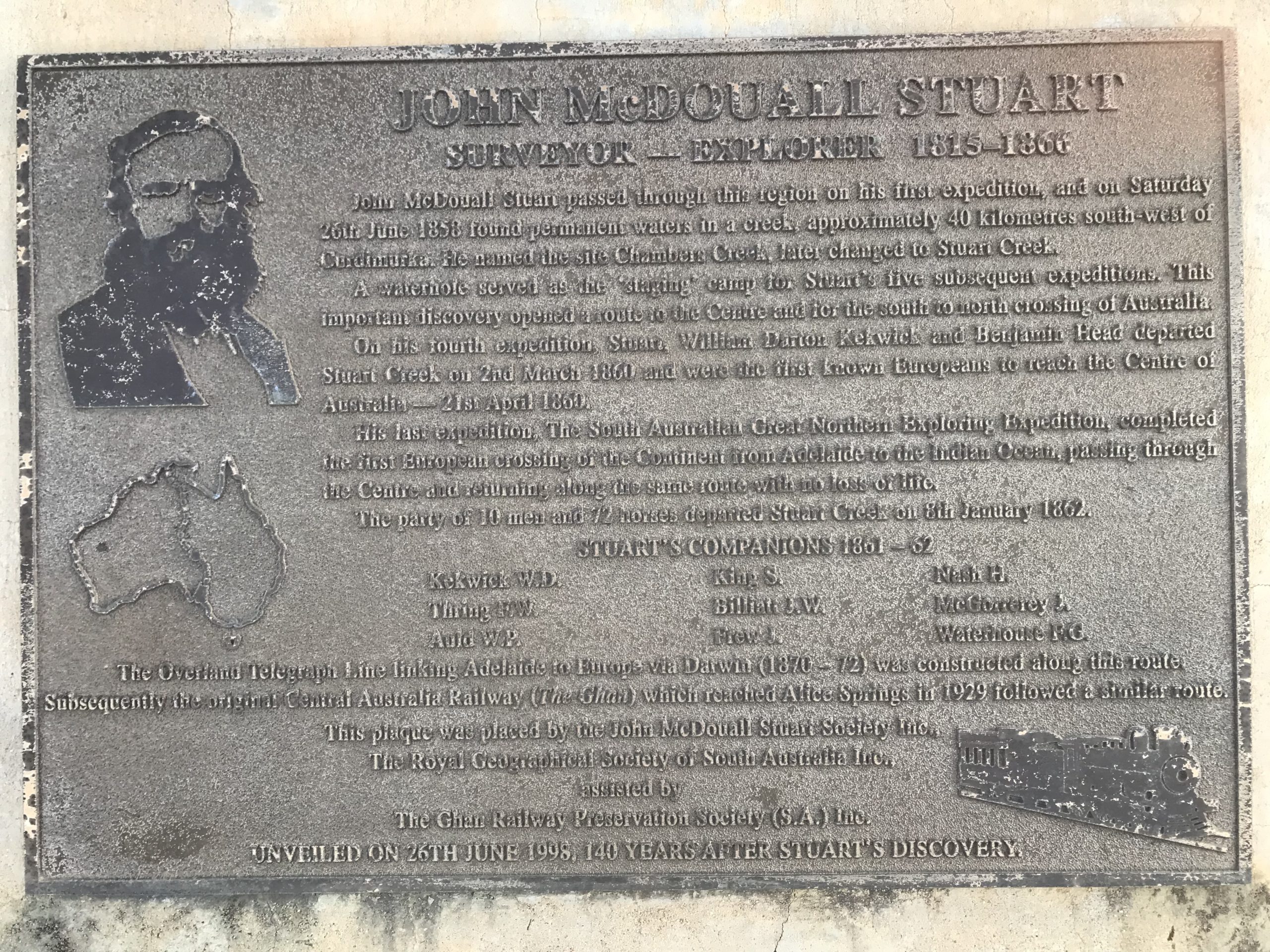
Stuart Plaque at Curdimurka

The Stuart Expeditions and The Inland Telegraph
John McDouall Stuart was a Scottish-born Australian explorer who played a critical role in opening up the inland regions of Australia to European settlement in the mid-19th century. His expeditions through the heart of the continent were instrumental in laying the groundwork for the construction of the original Ghan railway from Adelaide to Darwin.
Stuart made a total of six expeditions through the centre of Australia between 1858 and 1862. On his fourth expedition in 1860-61, he led a party that became the first Europeans to cross the continent from south to north. Stuart and his team travelled from Adelaide to the north coast of Australia, passing through what is now known as Alice Springs and the Oodnadatta Track. Along the way, they mapped vast stretches of previously unexplored territory, and opened up new routes for settlement and development.
Stuart’s explorations were significant in several ways for the development of the Ghan railway. First, his expeditions established the viability of a route through the interior of Australia, which was previously considered impassable. Second, Stuart’s explorations helped to identify key water sources and landmarks that would be critical for the construction and operation of the railway. Finally, Stuart’s travels through central Australia helped to build a base of knowledge and understanding of the region, which would be critical for the engineers and workers who built the Ghan railway decades later.
When construction of the original Ghan railway began in the late 19th century, the route followed many of the same paths that Stuart had explored decades earlier. The railway connected Marree to Oodnadatta, Alice Springs and Darwin, and became a critical transportation link for the region. Today, the Ghan railway is one of the world’s most iconic train journeys, and it continues to follow in the footsteps of the early explorers and pioneers who opened the Australian outback to the world.
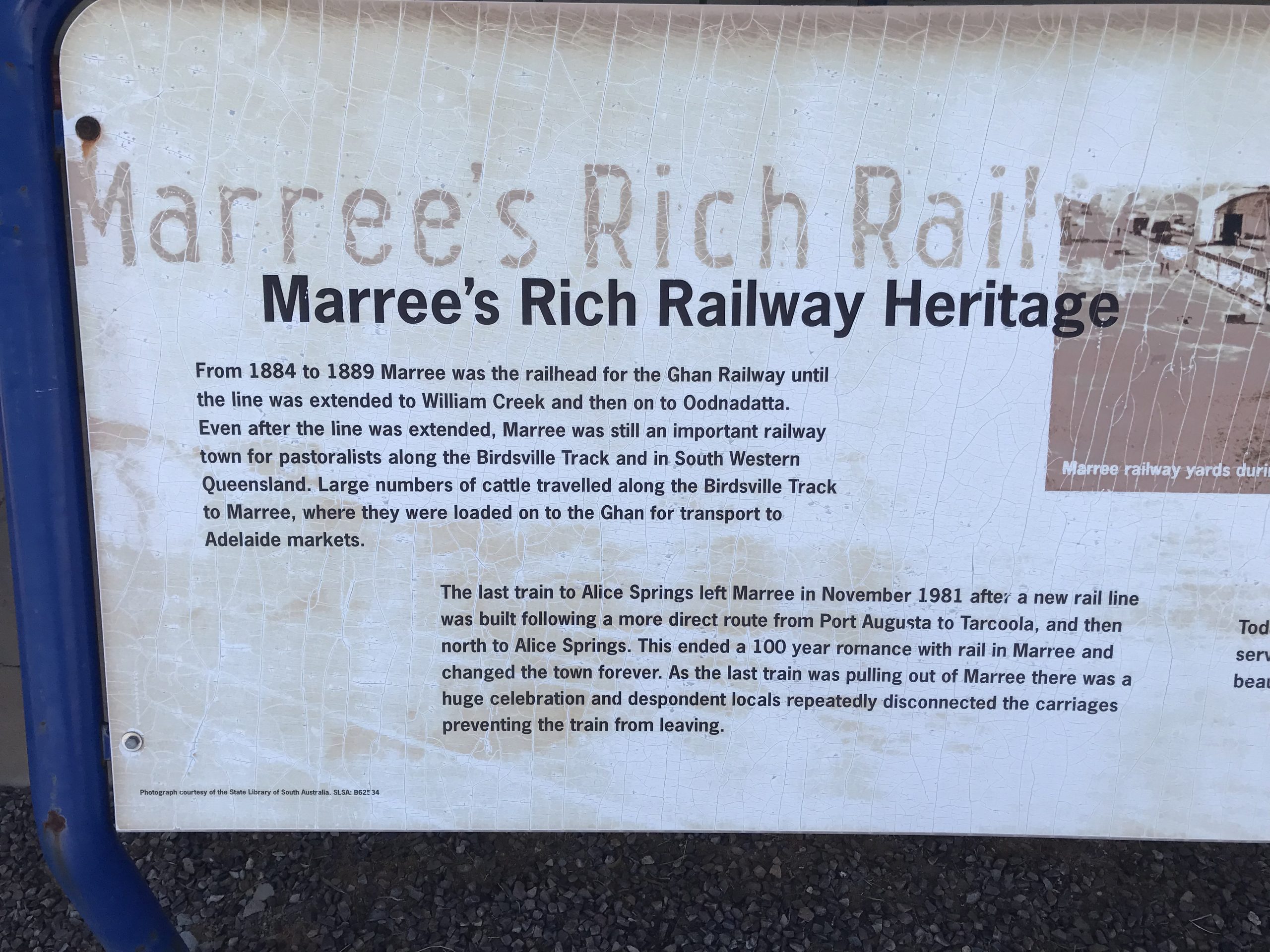

The Rail Story
The original Ghan railway was a standard-gauge railway that was built in the early 20th century to connect the South Australian capital of Adelaide to the Northern Territory city of Darwin. The Ghan railway followed a different route through the Australian outback, passing through Marree, Oodnadatta, Alice Springs, and other key towns and landmarks along the way.
The first railway line went through Quorn and onto Marree. It was known as the Great Northern Express and the Afghan Express and it was built in the late 1800s to serve the pastoral and mining industries of the Flinders Ranges and the northern regions of South Australia. The line was later incorporated into the route of the original Ghan railway that linked Adelaide to Alice Springs and Darwin.
The Great Northern Railway had several stops along the way between Port Augusta and Marree. After leaving Port Augusta, the railway line passed through the towns of Wilmington and Quorn, which were important railway junctions for the region. From Quorn, the line continued northward to the towns of Hawker, Parachilna, and Leigh Creek, before finally reaching Marree, which was then known as Hergott Springs.
Each of these towns served as important stopping points for the railway line, providing a vital link between the remote outback communities and the wider world. The railway line brought supplies, people, and equipment to the region, and it played a critical role in the development of the pastoral, mining, and transportation industries in the Flinders Ranges and beyond.
Today, many of these towns still have historic railway stations and other infrastructure that are reminders of the railway’s importance to the region’s history and culture.
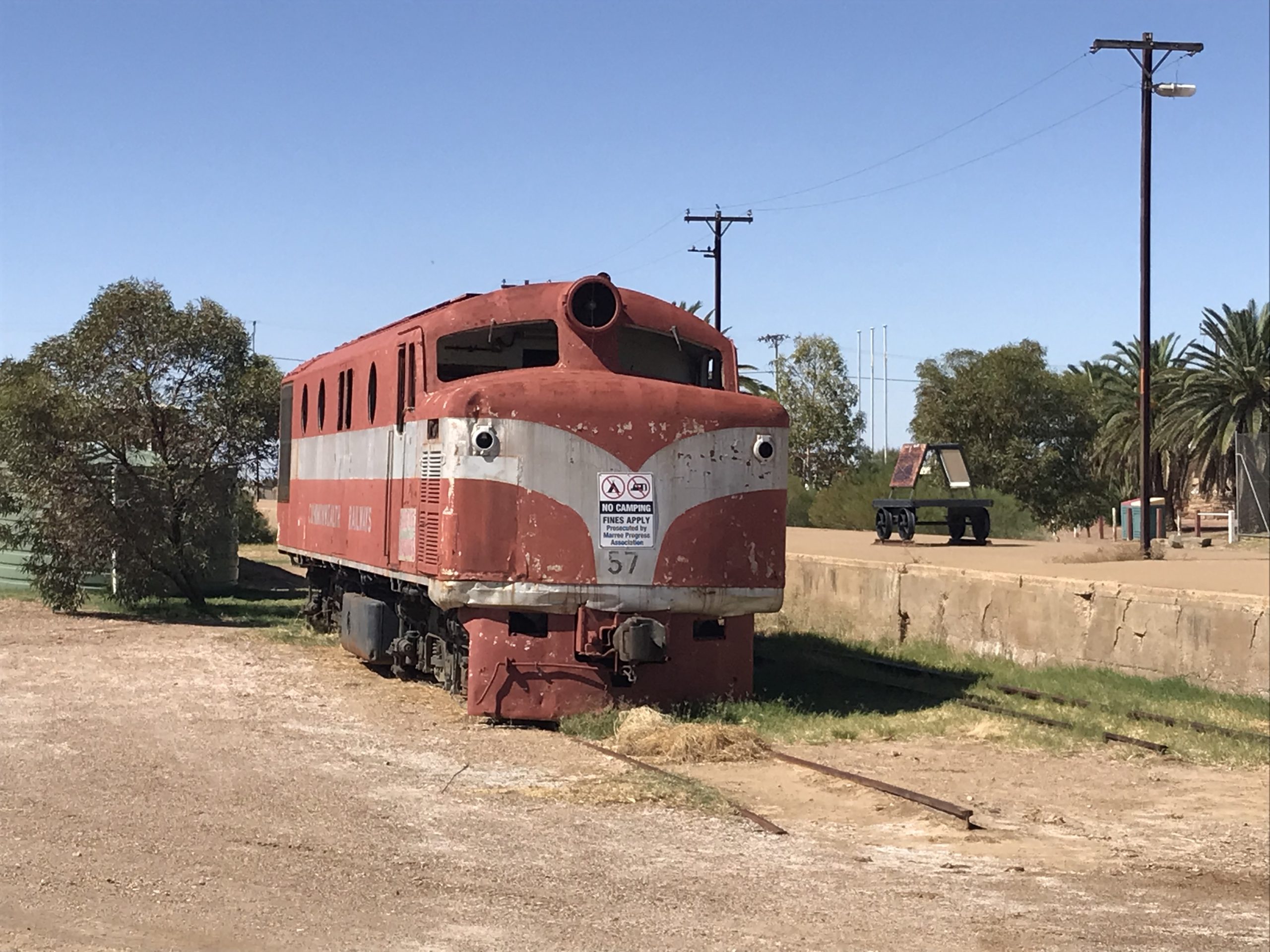

Marree
Marree is the home for the original Afghan Cameleers from where the Ghan gets it name. The Cameleers provided the necessary support transport for the construction of the Overland Telegraph. Today an old locomotive sits beside the disused railway station and serves as a reminder of a long-gone era.
Prior to the establishment of the Marree Railhead, cattle had to be driven long distances overland to reach markets in the south, which was a difficult and dangerous undertaking. The establishment of the railhead enabled cattle to be transported by train, which was a faster and safer method of transportation. The railhead was strategically located near the intersection of several important stock routes, which allowed cattle to be transported from as far away as Western Australia and Queensland.
The town also played a key role in the establishment of iconic Australian brands such as R.M. Williams. His connection to the Marree Railhead and the cattle industry comes through his work as a drover and as a supplier of goods and services to the industry. In the 1940s and 1950s, Williams established a store and workshop at the Marree Railhead, which became an important hub for drovers and stockmen travelling through the area. The store sold Williams’ boots and clothing, as well as other goods and supplies that were essential for life on the road. R.M. Williams became a celebrated figure in Australian culture and an important symbol of the country’s frontier history. Today, his boots and clothing remain an icon of Australian fashion, and his legacy continues to be celebrated in rural communities across the country.

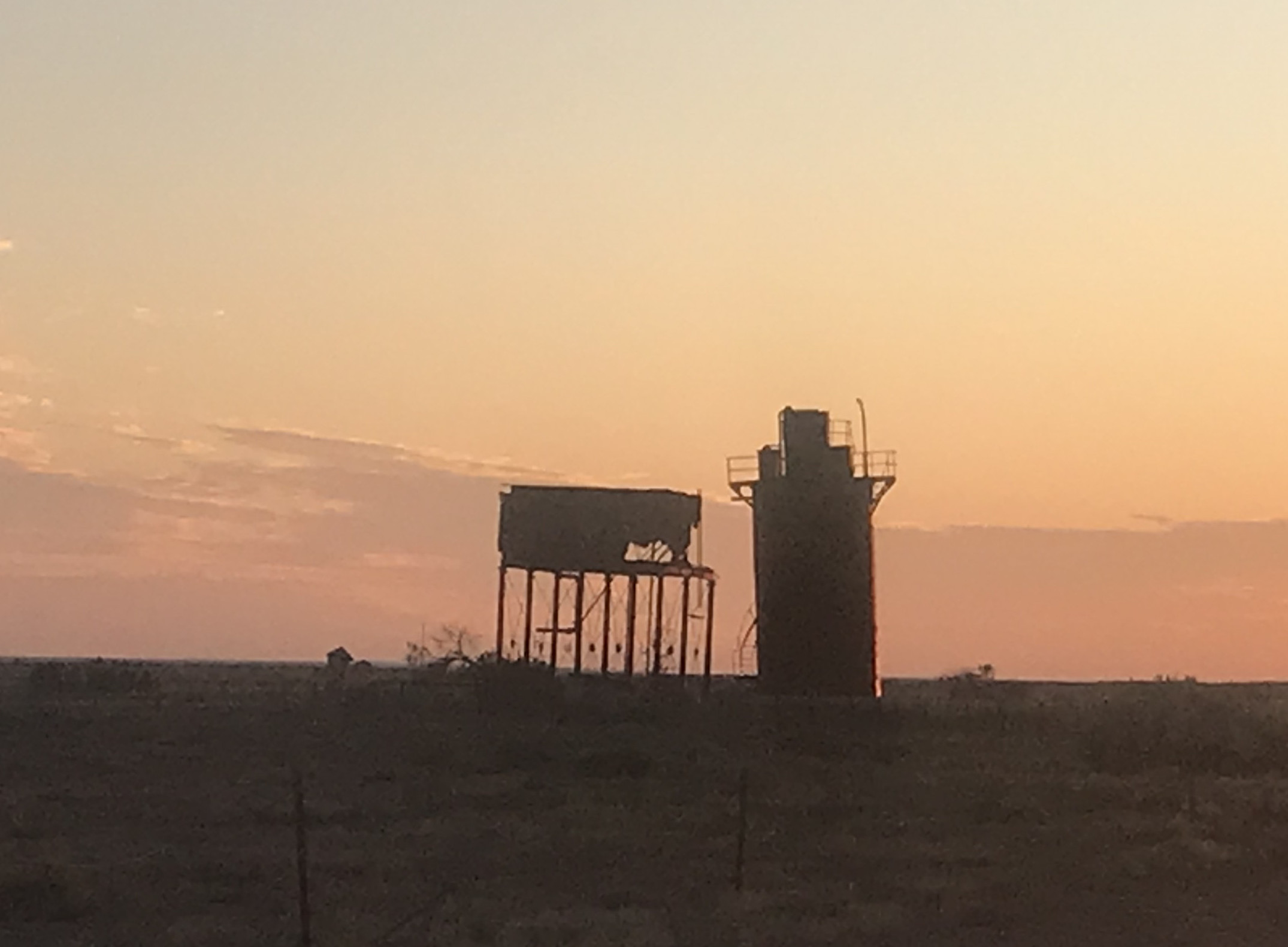
Mound Springs
Mound Springs was the enabler of Stuart’s expedition and thus the inland telegraph and the Ghan Railway to Alice Springs.
Firstly, the mound springs are an important feature of the landscape in the arid regions of central Australia. These are natural springs that emerge from the ground and form small mounds of sediment and mineral deposits. They are important sources of water for the local flora and fauna, as well as for the indigenous people who have lived in the area for thousands of years. By following the path of the mound springs, the Ghan railway was able to access sources of water for its steam locomotives and for the people who lived and worked along the route.
Secondly, the ancient indigenous people of central Australia. This route has been used for thousands of years by indigenous people to trade goods and knowledge between different communities. The Ghan railway route therefore follows an important cultural pathway, which has been shaped by the traditional knowledge and practices of the indigenous people who have lived in the area for generations.
Finally, the decision to follow the mound springs and the ancient indigenous trading route was also influenced by the practicalities of constructing a railway in such a remote and challenging landscape. The mound springs provided sources of water and fertile land for the construction of railway towns, while the indigenous trading route provided a relatively accessible path through the rugged terrain of central Australia.
Overall, the decision to follow the mound springs and the ancient indigenous trading route in the construction of the Ghan railway was shaped by a combination of practical, cultural, and environmental factors. The result is a railway route that is not only practical and efficient, but also deeply connected to the history, culture, and landscape of central Australia.
Today, there are many relics, old water towers, old sidings, old telegraph stations in an otherwise barren landscape which reminds us of the difficulties and the harshness of the conditions that were encountered building the first railway crossing.


Curdimurka
The Curdimurka railway siding was built in the late 1800s as part of the original Ghan railway line, and it served as a critical transport hub for the region’s pastoral and mining industries. In its heyday, the siding was a bustling hub of activity, with trains passing through regularly and goods being loaded and unloaded.
The Curdimurka Ball was an annual event held near the town of Marree in South Australia, and it was popular with both locals and visitors to the region. The ball is held in the historic Curdimurka railway siding, which is located on the old Ghan railway line, and it is a celebration of the region’s rich cultural heritage.
Alice Springs
It is a place of striking natural beauty, with red sandstone cliffs, expansive deserts, and clear blue skies. The town itself is a melting pot of cultures, where the traditional lifestyles of the Arrernte people blend with the influences of Western civilization. But the true heart of Alice Springs lies in its rugged landscape, which stretches as far as the eye can see. Here, visitors can explore ancient gorges, hike through towering rock formations, and witness breath-taking sunsets over the desert. The Ghan Railway trip to Alice Springs is the perfect way to experience the beauty of the Red Centre, as it takes you through some of the most remote and awe-inspiring landscapes in the world. This country around Alice Springs and Hermannsburg is the country of the famous artist Albert Namatjira who depicted the colour of the outback in some striking watercolours.


Overland Telegraph Station at Alice Springs
Overland Telegraph Line was built in the late 1800s to connect Australia with the rest of the world through a telegraph line running from Adelaide to Darwin, and then across the seas to Asia and beyond. The construction of the line was a remarkable engineering feat, as it involved traversing some of the most remote and challenging terrain in the world.
The Ghan railway was built several decades later, in the early 20th century, and it follows much of the same route as the Overland Telegraph Line. This was a deliberate choice by the railway planners, as the route had already been surveyed and cleared for the telegraph line, and many of the infrastructure and supply networks needed for the railway were already in place.
Today, travellers on the Ghan railway can see many of the historic sites and landmarks associated with the Overland Telegraph Line, including the Telegraph Station at Alice Springs, which is now a museum, and the many stone repeater stations that were established along the line to relay messages across the vast distances of central Australia.
Overall, the Ghan railway’s alignment with the historic Overland Telegraph Line is a significant part of its history and cultural heritage, and it provides a unique and fascinating window into the history of Australia’s early communication and transportation networks.











